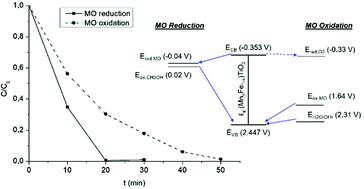Photo-oxidative and photo-reductive capabilities of ilmenite-rich black sand concentrates using methyl orange as a probe molecule
Abstract
Ilmenite-rich black sands from an alluvial deposit of Barbacoas (Nariño, Colombia) were used as a natural source aiming to obtain a low-cost and highly available photocatalyst. Mineral concentrates were obtained by gravimetric concentration in a Wilfley table (deck tilt angle: 11–14°) followed by dry magnetic or wet electromagnetic separation. Afterwards, the particle size was manually reduced down to −325 mesh. Rietveld refinements using X-ray diffraction data showed that the highest purity achieved was 93.46% of ilmenite (FeTiO3). Scanning electron microscopy coupled with energy dispersive X-ray spectroscopy revealed a polyhedral morphology with an average grain size of 1.33–2.27 μm, granular inclusions of aluminosilicates and appreciable quantities of manganese. The band-gap values determined by UV-Vis diffuse reflectance spectroscopy were underestimated compared to those reported in the literature, given the impurities in the samples and their optical behavior. Photoluminescence experiments provided a band-gap of 2.68 eV. The photo-oxidative and photo-reductive capabilities of the concentrates were evaluated in the degradation of methyl orange in aqueous solution under UV irradiation. 99% of discoloration was achieved after 50 min for oxidation and after 20 min for reduction, showing the potential of ilmenite-rich concentrates as photocatalysts.

- This article is part of the themed collection: Solar chemistry & photocatalysis: environmental applications – SPEA10


 Please wait while we load your content...
Please wait while we load your content...